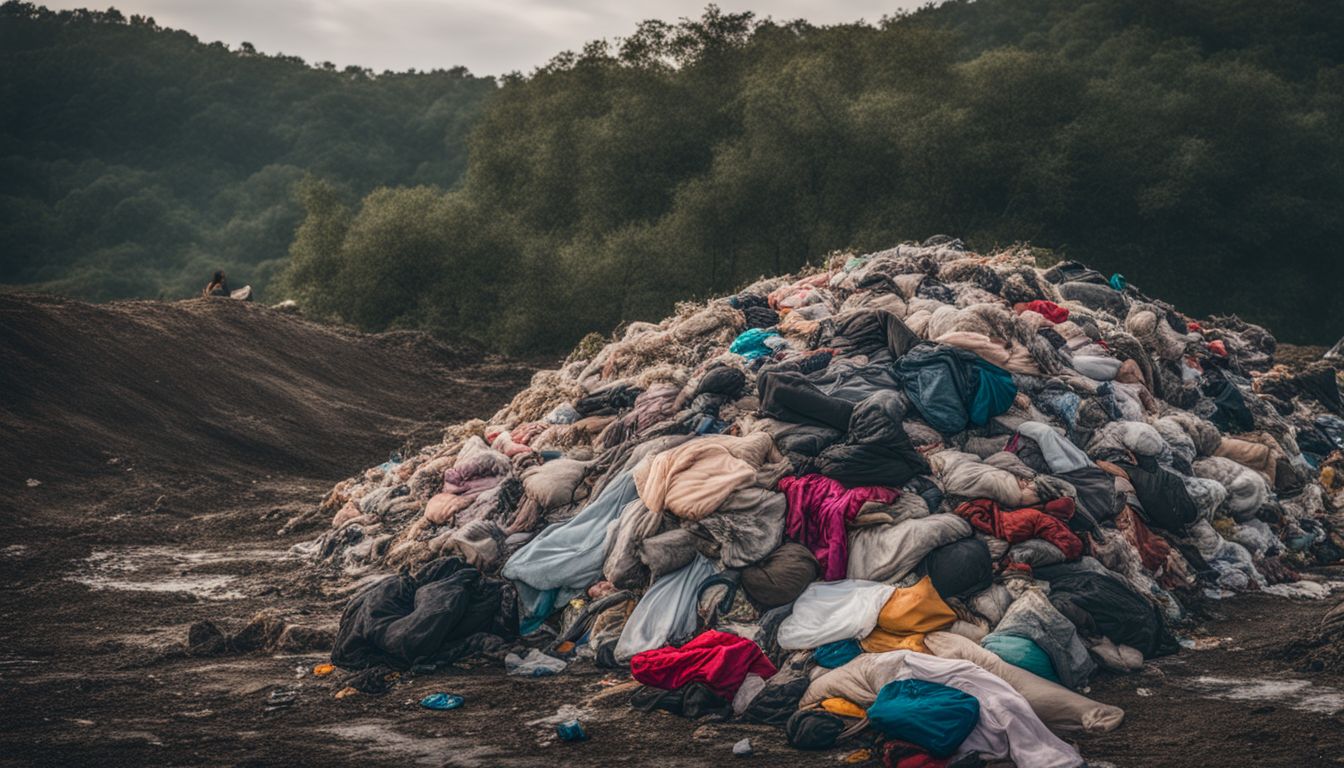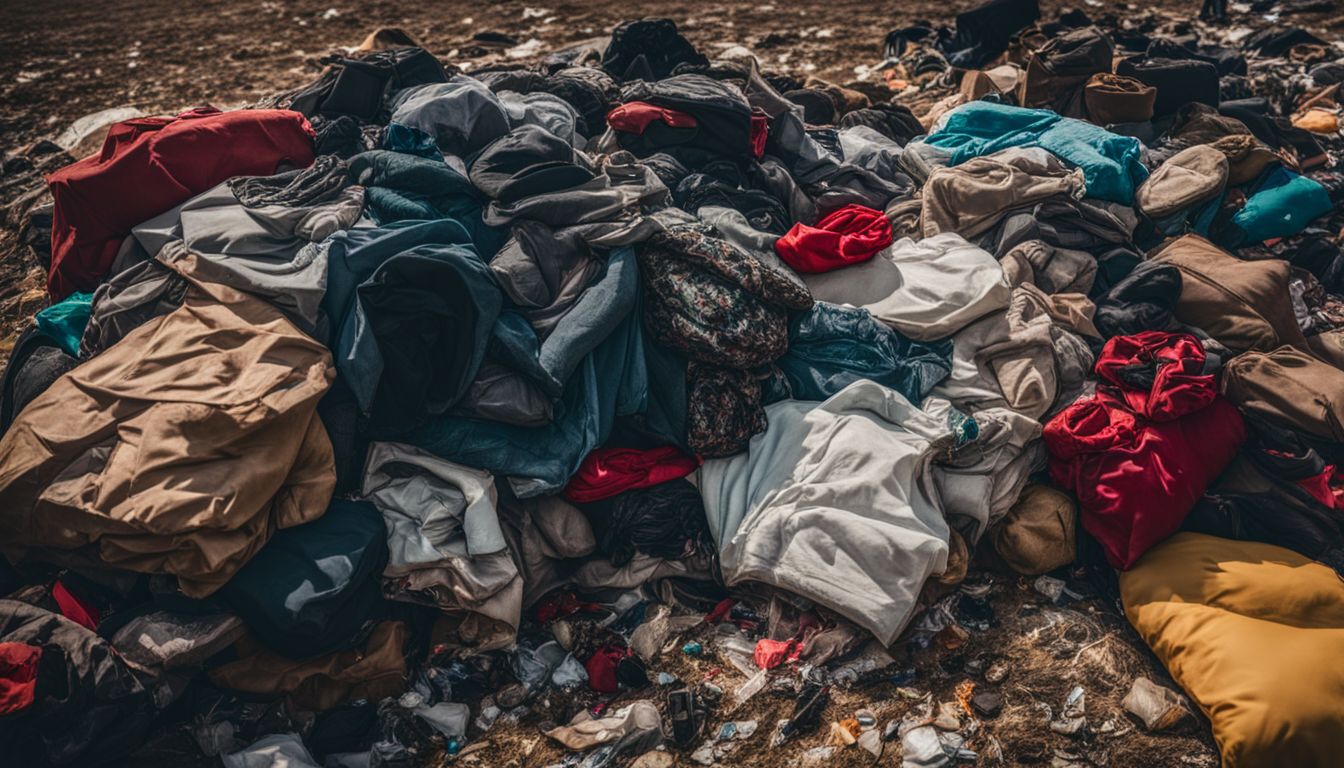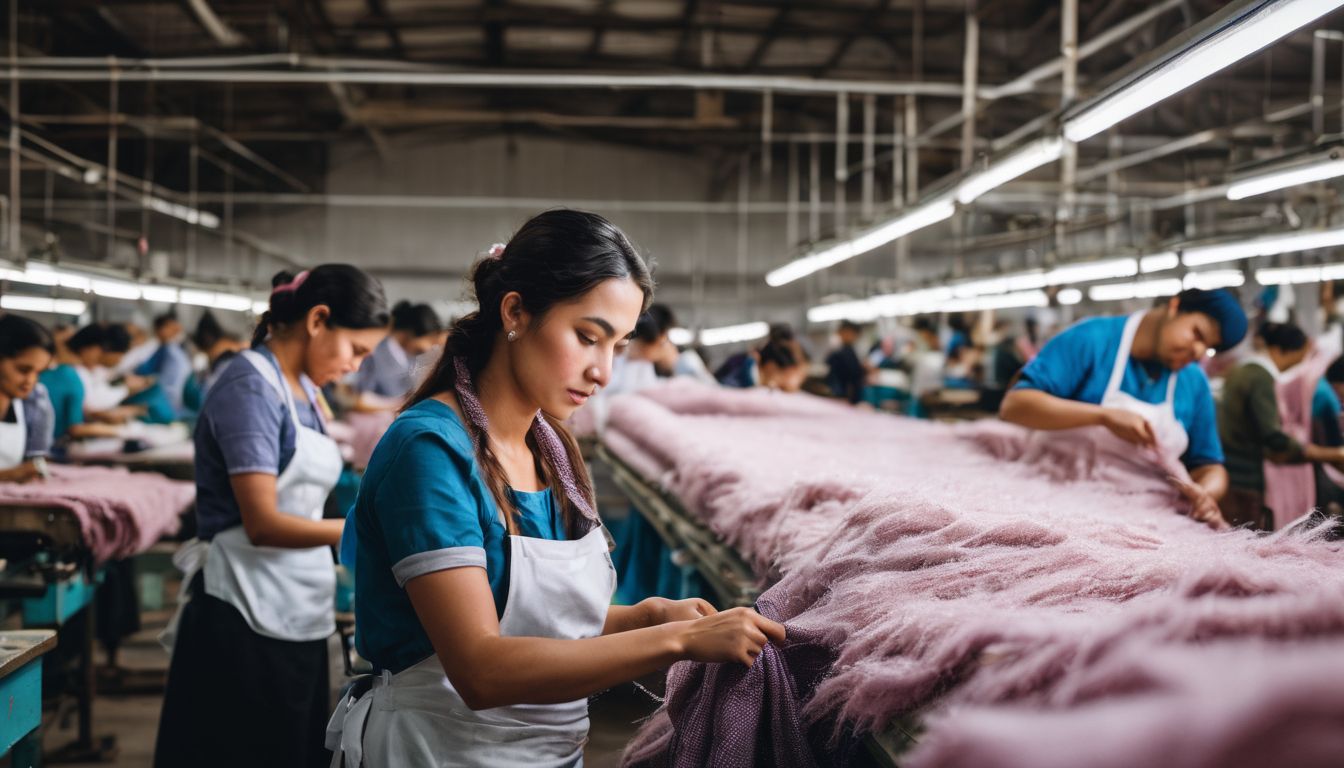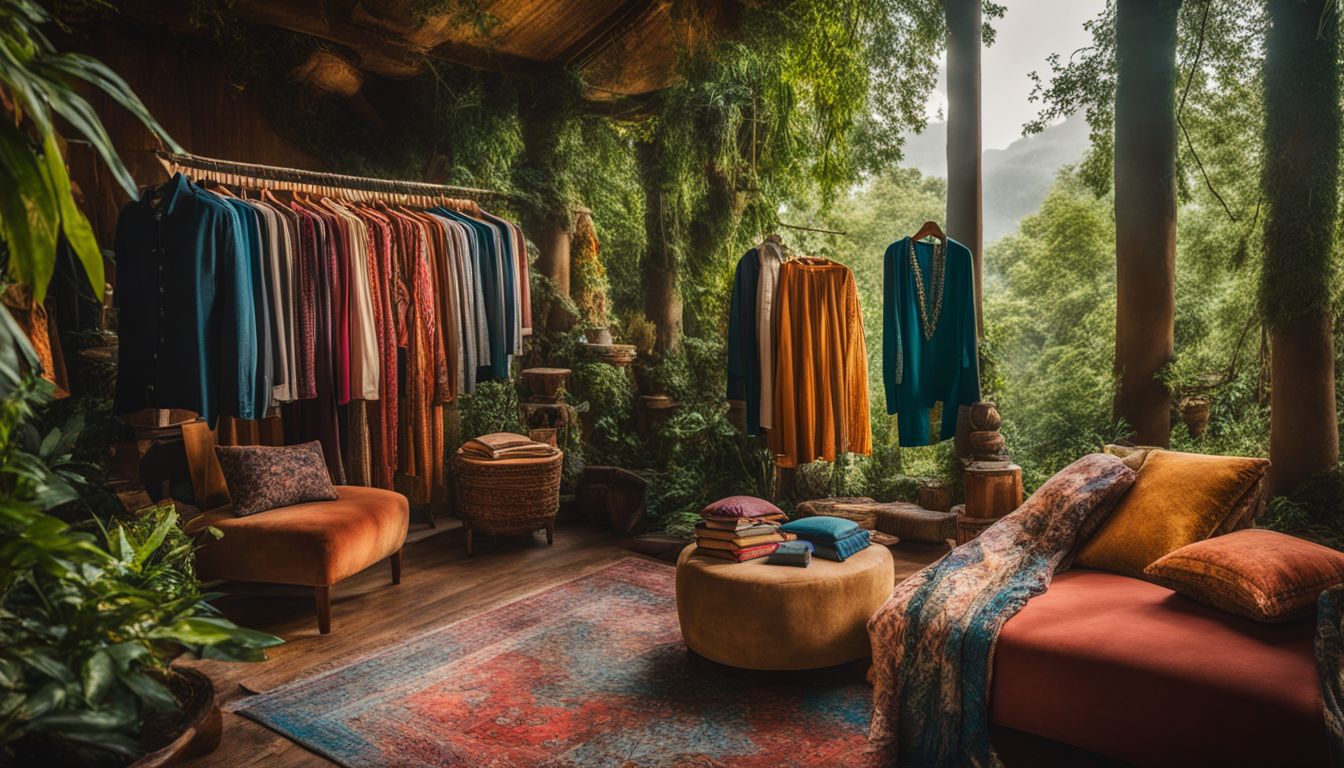We all love keeping up with the latest fashions, but have you ever considered its impact on our planet? It’s shocking to know that the fashion industry is responsible for 8% of global waste.
This blog post will shed light on sustainable fashion — a growing trend aiming to reduce this environmental harm. Stay tuned to find out why is sustainable fashion important and how choosing eco-conscious threads can help save Mother Earth!
Key Takeaways
- Sustainable fashion is important because it helps reduce waste and conserve natural resources.
- By supporting sustainable fashion brands, we can promote fair wages and safe working conditions for garment workers.
- Choosing eco – friendly materials and ethical manufacturing practices in the fashion industry can help lower our carbon footprint and combat climate change.
What is Sustainable Fashion?

Sustainable fashion is a concept that promotes clothing and accessories produced with consideration for the environment and social impact throughout their life cycle.
Definition of sustainable fashion

Sustainable fashion is about making clothes in a way that cares for the earth. It uses less water and creates less waste. Brands who follow this idea aim to cut down damage they may cause to our world.
They use stuff that can be used again or things that won’t harm our environment when made into clothes. Some call it “green fashion“. Others think of it as being fair and kind to people who make these items too.
This is not just about the earth, but also about human rights and pay checks for hard work.
Examples of sustainable fashion brands
 Sustainable fashion brands are becoming more popular and accessible, offering eco-friendly and socially responsible alternatives to traditional fashion choices. Here are some examples of sustainable fashion brands:
Sustainable fashion brands are becoming more popular and accessible, offering eco-friendly and socially responsible alternatives to traditional fashion choices. Here are some examples of sustainable fashion brands:
- Patagonia: Known for its commitment to environmental sustainability, Patagonia focuses on using recycled materials and reducing waste in its production processes.
- Eileen Fisher: Eileen Fisher promotes fair trade practices and sustainable sourcing of materials. They also have a take-back program to recycle old garments.
- People Tree: People Tree is a pioneer in Fair Trade fashion, ensuring fair wages and safe working conditions for their workers while using organic and eco-friendly materials.
- Reformation: Reformation emphasizes transparency in their supply chain and uses sustainable fabrics like Tencel and recycled polyester.
- Stella McCartney: Stella McCartney is known for her commitment to animal welfare, using vegan materials and avoiding the use of fur or leather.
- Amour Vert: Amour Vert uses organic cotton and non-toxic dyes in their clothing production, promoting sustainable farming practices.
- Veja: Veja produces eco-friendly sneakers made from organic cotton, wild rubber, and recycled plastic bottles.
- Alternative Apparel: Alternative Apparel focuses on creating basics made from sustainable materials such as organic cotton, recycled polyester, and low-impact dyes.
Environmental Impacts of Fashion

Fashion has significant environmental impacts, including waste generation, water usage and pollution, contribution to climate change, and microplastic pollution.
Waste generation

The fashion industry generates a significant amount of waste. In fact, the apparel and footwear industries together account for around 8% of the world’s waste. Our landfills are filled with textile waste that takes hundreds of years to decompose.
This overproduction and disposal contribute to pollution and harm the environment. Fast fashion, which relies on producing cheap clothing quickly, contributes heavily to this waste generation.
By embracing sustainable fashion practices, brands can reduce their impact on the environment and help minimize the amount of waste produced in the industry.
Water usage and pollution

Sustainable fashion is important because it addresses the water usage and pollution caused by the fashion industry. Did you know that it takes more than 700 gallons of water to make a single t-shirt? This excessive use of water depletes our natural resources and puts pressure on freshwater systems.
Additionally, the fashion industry is the second-largest consumer of the world’s water supply. Not only does sustainable fashion help in reducing water usage, but it also plays a role in minimizing pollution.
The production processes involved in conventional fashion often involve toxic chemicals that end up polluting rivers and harming aquatic ecosystems. By supporting sustainable fashion brands that prioritize eco-friendly materials and responsible manufacturing practices, we can contribute to preserving our precious water resources and protecting the environment.
Contribution to climate change

The fashion industry contributes to climate change in several ways. One of the main factors is the production of greenhouse gas emissions during clothing manufacturing processes, such as spinning, weaving, dyeing, and finishing.
Additionally, transportation and distribution of garments also release carbon dioxide into the atmosphere. Another significant contributor is the cultivation and processing of raw materials like cotton and synthetic fibers, which require large amounts of energy and water.
Moreover, fast fashion’s emphasis on rapid production and disposal leads to increased waste generation and further exacerbates environmental impacts. It is crucial for the fashion industry to adopt sustainable practices that reduce its carbon footprint and prioritize more environmentally friendly alternatives in order to mitigate climate change effects.
Microplastic pollution
 Microplastic pollution is another significant environmental impact of the fashion industry. Microplastics are tiny pieces of plastic that measure less than 5mm in size and can come from sources such as synthetic fabrics, microbeads in personal care products, and the breakdown of larger plastic items.
Microplastic pollution is another significant environmental impact of the fashion industry. Microplastics are tiny pieces of plastic that measure less than 5mm in size and can come from sources such as synthetic fabrics, microbeads in personal care products, and the breakdown of larger plastic items.
When we wash our clothes made of synthetic materials like polyester or nylon, small particles called microfibers are released into the water system. These microfibers can then end up in rivers, lakes, and oceans where they are ingested by marine life.
This not only poses a threat to aquatic ecosystems but also has the potential to enter our food chain when we consume seafood. It’s estimated that around 35% of all primary microplastics found in the ocean come from synthetic textiles like clothing.
Social Impacts of Fashion

– Fair wages and working conditions: Many fashion brands exploit workers in developing countries by paying low wages and subjecting them to hazardous working conditions. By supporting sustainable fashion, we can help ensure that garment workers are paid fair wages and have safe working environments.
Read more about the social impacts of fashion here!
Fair wages and working conditions

Workers in the fashion industry deserve fair wages and safe working conditions. Unfortunately, many clothing manufacturers exploit laborers by paying them low wages and subjecting them to unsafe environments.
Sustainable fashion brands prioritize ethical manufacturing practices and ensure that their workers are treated fairly. This means providing fair wages, safe working conditions, and protecting the rights of employees.
By supporting sustainable fashion, you are contributing to a more just and equitable industry where workers are respected and valued for their contributions.
Avoidance of child labor

Sustainable fashion promotes the avoidance of child labor, which is a serious issue in the fashion industry. Many fast fashion brands rely on cheap labor, often employing children in unsafe and exploitative working conditions.
By supporting sustainable fashion brands, we can help ensure that workers are treated fairly and that no child is forced into labor. Sustainable fashion brands prioritize ethical manufacturing practices, such as fair wages and safe working conditions for all employees.
This not only protects the rights of workers but also helps to create a more socially responsible and compassionate fashion industry overall.
Support for ethical manufacturing practices

Sustainable fashion is not only about protecting the environment, but also about promoting ethical practices in manufacturing. When brands prioritize ethical manufacturing practices, it means that they are ensuring fair wages and working conditions for their workers, avoiding child labor, and supporting a supply chain that is transparent and accountable.
This helps to create a more socially responsible fashion industry that values the well-being of its workers and respects human rights. By supporting sustainable fashion brands that prioritize ethical manufacturing practices, consumers can contribute to positive change in the industry and promote fairness and equality.
Benefits of Sustainable Fashion

Sustainable fashion offers numerous benefits, including reduced waste and resource consumption, a lower carbon footprint, preservation of natural resources, healthier and safer products, as well as support for ethical and responsible practices.
Reduced waste and resource consumption
Sustainable fashion plays a crucial role in reducing waste and resource consumption. By adopting sustainable practices, brands can minimize their environmental impact throughout the entire lifecycle of a garment.
This includes using eco-friendly materials that require fewer resources to produce, implementing efficient manufacturing processes, and promoting circular fashion by encouraging recycling and upcycling clothing.
These measures help conserve precious natural resources like water and energy while also minimizing the amount of waste ending up in landfills. By choosing sustainable fashion options, consumers can actively contribute to reducing waste and supporting responsible resource consumption in the industry.
Lower carbon footprint
Sustainable fashion helps to lower the carbon footprint of the fashion industry. Carbon footprint refers to the amount of greenhouse gases emitted during the production, transportation, and disposal of clothing.
Fast fashion, with its high turnover rate and cheap manufacturing processes, contributes significantly to carbon emissions. By choosing sustainable fashion brands that prioritize eco-friendly materials and ethical practices, we can reduce our carbon footprint.
Sustainable fashion also encourages a shift towards a circular economy, where clothes are recycled or upcycled instead of being thrown away after a short period of use. This reduces waste and further decreases carbon emissions associated with producing new garments.
Preservation of natural resources
Sustainable fashion plays a crucial role in the preservation of natural resources. The fashion industry is known for its excessive use of materials like water, energy, and raw materials.
By embracing sustainable practices, such as using organic and eco-friendly materials and adopting circular approaches to production, the fashion industry can significantly reduce its impact on the environment.
This means less water wasted, fewer non-renewable resources consumed, and reduced pollution caused by the extraction and processing of raw materials. Sustainable fashion helps protect our precious natural resources for future generations while still allowing us to express our style.
Healthier and safer products
Sustainable fashion also focuses on creating healthier and safer products for both consumers and workers in the industry. Traditional fashion practices often involve the use of harmful chemicals, such as pesticides and toxic dyes, which can have negative effects on our health.
Sustainable fashion brands prioritize using natural and organic materials that are free from these harmful substances, reducing the risk of allergies, skin irritation, and other health issues.
Furthermore, sustainable fashion promotes fair working conditions for garment workers, ensuring their safety and well-being. By choosing sustainable fashion, we can support brands that prioritize our health and the health of those involved in the production process.
Support for ethical and responsible practices
Sustainable fashion supports ethical and responsible practices throughout the entire supply chain. This means that brands prioritize fair wages and working conditions for garment workers, avoiding the use of child labor, and ensuring that manufacturing processes are environmentally friendly.
By supporting sustainable fashion, we can contribute to a more socially responsible industry where workers are treated fairly and ethically sourced materials are used in production.
It’s important to choose brands that align with these values and advocate for transparency in the fashion industry.
How to Support Sustainable Fashion

Support sustainable fashion by choosing brands and products that prioritize environmentally friendly materials and ethical manufacturing practices, educating yourself about sustainable fashion, extending the lifespan of your clothes through proper care and repairs, supporting secondhand and vintage clothing, advocating for transparency and ethically sourced materials, and promoting sustainable fashion through social media and word of mouth.
Choose sustainable brands and products
- Look for clothing brands that prioritize sustainability and ethical practices.
- Seek out brands that use eco – friendly materials, such as organic cotton or recycled fabrics.
- Consider purchasing garments from companies that promote fair trade and support workers’ rights.
- Opt for brands that minimize waste and utilize circular fashion principles by repurposing or recycling materials.
- Support local and small – scale businesses that prioritize sustainable production methods.
- Research and choose brands with transparent supply chains, so you know where your clothes are coming from.
- Check for certifications or labels indicating a brand’s commitment to sustainability, such as Fair Trade or GOTS (Global Organic Textile Standard).
- Prioritize quality over quantity when shopping, investing in well – made pieces that will last longer.
- Consider buying secondhand or vintage clothing to reduce demand for new items and extend the lifespan of garments.
- Share your support for sustainable brands and products on social media to raise awareness and encourage others to make eco-conscious choices.
Remember, choosing sustainable fashion can have a positive impact on the environment while supporting ethical manufacturing practices.
Educate yourself about sustainable fashion
To support sustainable fashion, it’s important to educate yourself about it. Here are some ways to learn more:
- Read books and articles about sustainable fashion.
- Follow blogs and social media accounts that focus on sustainable fashion.
- Watch documentaries or videos that discuss the impact of the fashion industry.
- Attend workshops or seminars on sustainable fashion.
- Join online communities or forums where people discuss sustainable fashion.
- Learn about different certifications and labels that indicate sustainable practices in fashion.
- Stay up to date with current trends and innovations in sustainable fashion.
- The overproduction rates of the fashion industry harm the environment.
- The average consumer now buys 60% more clothing than they did 15 years ago.
Extend the lifespan of your clothes through proper care and repairs
Proper care and repairs can help extend the lifespan of your clothes, reducing waste and saving resources. Here are some tips:
- Wash your clothes less frequently to prevent wear and tear.
- Follow the care instructions on the labels to ensure you’re using the right methods and temperature.
- Repair small damages like loose buttons or ripped seams instead of throwing the garment away.
- Learn basic sewing skills so you can mend clothes yourself or find a local tailor who can help.
- Avoid overloading your washing machine or dryer to prevent stretching or shrinking of fabrics.
- Store your clothes properly in a clean, dry place to protect them from damage.
- Invest in quality clothing that is made to last longer.
Support secondhand and vintage clothing
Supporting secondhand and vintage clothing is an important way to promote sustainable fashion. It helps reduce waste and gives new life to pre-loved items. Here’s how you can support secondhand and vintage clothing:
- Shop at thrift stores, consignment shops, or online platforms that sell secondhand clothing.
- Donate your gently used clothing instead of throwing them away.
- Host or participate in clothing swaps with friends and family.
- Embrace the unique styles and stories behind vintage clothing.
- Consider altering or repairing secondhand pieces to fit your style and preferences.
- Educate others about the benefits of buying secondhand and vintage clothing.
Advocate for transparency and ethically sourced materials
Advocate for transparency and ethically sourced materials by:
- Supporting brands that disclose information about their supply chains and manufacturing processes.
- Choosing products made from sustainable and responsibly sourced materials, such as organic cotton or recycled fabrics.
- Encouraging brands to provide certifications or labels that verify their ethical practices.
- Asking questions about a brand’s commitment to fair trade, worker rights, and environmental sustainability.
- Sharing information and resources about ethical fashion with others through social media and word of mouth.
- Participating in campaigns or initiatives that promote transparency and responsible sourcing in the fashion industry.
Promote sustainable fashion through social media and word of mouth
Promoting sustainable fashion is an important way to make a positive impact. Here are some ways you can help spread the word:
- Share posts on social media about sustainable fashion brands and initiatives.
- Use hashtags like #sustainablefashion or #ethicalfashion to raise awareness.
- Recommend sustainable fashion brands to your friends and family.
- Talk about the importance of sustainable fashion in conversations with others.
- Attend or organize events that promote sustainable fashion.
- Write reviews and blog posts about your favorite sustainable fashion brands.
- Collaborate with influencers and bloggers who support sustainability.
- Support local businesses that prioritize ethical and eco-friendly practices.
Conclusion

In conclusion, sustainable fashion is important because it helps protect the environment and supports fair treatment for workers. By choosing ecofriendly materials, reducing waste, and advocating for ethical practices, we can make a positive impact on the fashion industry.
Let’s embrace conscious consumerism and support sustainable brands to create a more responsible and environmentally friendly fashion industry.
FAQs
1. What is sustainable fashion?
Sustainable fashion, also known as green fashion or ecoconscious fashion, uses environmentally friendly materials and ethical production methods.
2. Why is ecofriendly fashion important?
Ecofriendly textiles help to cut down the environmental impact of the fast-paced and waste-filled normal trends in the industry. It pushes a slow fashion movement that values quality over quantity.
3. What are some examples of fair trade in the sustainable Fashion Industry?
Fair Trade in fashion includes practices like ethical sourcing of materials, paying workers fairly, maintaining safe workplaces, and supporting circular economy models where nothing goes to waste.
4. How can I join the conscious consumerism movement in shopping for clothes?
To be part of conscious consumerism in shopping for clothes means choosing brands that value social responsibility over profit-making.You should look out for signs of greenwashing by companies who pretend to be more ‘green’ than they really are!
5. Does buying slow-fashion items make a difference?
Yes! When you buy from slow-fashion brands which follow principles like minimal design changes or seasonal collections , you support less wastage and more conscious consumption.

As a dedicated mother and passionate software developer, she weaves her diverse experiences into captivating stories that inspire and engage readers. Emma's love for sustainable living and environmental consciousness permeates both her personal and professional life. When she's not immersed in the world of coding and software development, Emma can be found nurturing her family and tending to her thriving organic garden. Her commitment to sustainable practices extends to every aspect of her life, from repurposing household items to embracing eco-friendly technologies.










